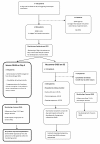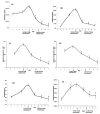Outpatient management of severe early OHSS by administration of GnRH antagonist in the luteal phase: an observational cohort study
- PMID: 22938051
- PMCID: PMC3489837
- DOI: 10.1186/1477-7827-10-69
Outpatient management of severe early OHSS by administration of GnRH antagonist in the luteal phase: an observational cohort study
Abstract
Background: Management of established severe OHSS requires prolonged hospitalization, occasionally in intensive care units, accompanied by multiple ascites punctures, correction of intravascular fluid volume and electrolyte imbalance. The aim of the present study was to evaluate whether it is feasible to manage women with severe OHSS as outpatients by treating them with GnRH antagonists in the luteal phase.
Methods: This is a single-centre, prospective, observational, cohort study. Forty patients diagnosed with severe OHSS, five days post oocyte retrieval, were managed as outpatients after administration of GnRH antagonist (0.25 mg) daily from days 5 to 8 post oocyte retrieval, combined with cryopreservation of all embryos. The primary outcome measure was the proportion of patients with severe OHSS, in whom outpatient management was not feasible.
Results: 11.3% (95% CI 8.3%-15.0%) of patients (40/353) developed severe early OHSS. None of the 40 patients required hospitalization following luteal antagonist administration and embryo cryopreservation. Ovarian volume, ascites, hematocrit, WBC, serum oestradiol and progesterone decreased significantly (P < 0.001) by the end of the monitoring period, indicating rapid resolution of severe OHSS.
Conclusions: The current study suggests, for the first time, that successful outpatient management of severe OHSS with antagonist treatment in the luteal phase is feasible and is associated with rapid regression of the syndrome, challenging the dogma of inpatient management. The proposed management is a flexible approach that minimizes unnecessary embryo transfer cancellations in the majority (88.7%) of high risk for OHSS patients.
Figures



Similar articles
-
Pregnancy and neonatal outcomes following luteal GnRH antagonist administration in patients with severe early OHSS.Hum Reprod. 2013 Jul;28(7):1929-42. doi: 10.1093/humrep/det114. Epub 2013 Apr 26. Hum Reprod. 2013. PMID: 23624582
-
[Efficacy analysis of letrozole combined with gonadotropin-releasing hormone antagonists in patients with high risk of ovarian hyperstimulation syndrome undergoing total embryo freezing].Zhonghua Yi Xue Za Zhi. 2024 Aug 6;104(30):2823-2829. doi: 10.3760/cma.j.cn112137-20240107-00044. Zhonghua Yi Xue Za Zhi. 2024. PMID: 39085150 Chinese.
-
Serum vascular endothelial growth factor levels following luteal gonadotrophin-releasing hormone antagonist administration in women with severe early ovarian hyperstimulation syndrome.BJOG. 2014 Jun;121(7):848-55. doi: 10.1111/1471-0528.12572. Epub 2014 Feb 12. BJOG. 2014. PMID: 24621101
-
Ovarian hyperstimulation syndrome prevention strategies: use of gonadotropin-releasing hormone antagonists.Semin Reprod Med. 2010 Nov;28(6):493-9. doi: 10.1055/s-0030-1265676. Epub 2010 Nov 16. Semin Reprod Med. 2010. PMID: 21082508 Review.
-
The prevention of ovarian hyperstimulation syndrome.J Obstet Gynaecol Can. 2014 Nov;36(11):1024-1033. doi: 10.1016/S1701-2163(15)30417-5. J Obstet Gynaecol Can. 2014. PMID: 25574681 Review. English, French.
Cited by
-
The effect of luteal phase gonadotropin-releasing hormone antagonist administration on IVF outcomes in women at risk of OHSS.Int J Reprod Biomed. 2016 Aug;14(8):507-10. Int J Reprod Biomed. 2016. PMID: 27679825 Free PMC article.
-
Fertility Preservation and Ovarian Hyperstimulation Syndrome Management in Cancer Care: A Pathophysiological Perspective on Gonadotropin-Releasing Hormone Agonists and Antagonists.Pathophysiology. 2024 Jun 7;31(2):288-297. doi: 10.3390/pathophysiology31020021. Pathophysiology. 2024. PMID: 38921726 Free PMC article. Review.
-
[The best evidence for the management of ovarian hyper-stimulation syndrome in patients undergoing assisted reproductive therapy].Zhejiang Da Xue Xue Bao Yi Xue Ban. 2024 Oct 25;53(5):632-640. doi: 10.3724/zdxbyxb-2024-0349. Zhejiang Da Xue Xue Bao Yi Xue Ban. 2024. PMID: 39319473 Free PMC article. Chinese.
-
Severe early-onset ovarian hyperstimulation syndrome with liver dysfunction in an IVF segmentation cycle.BMJ Case Rep. 2020 Jan 26;13(1):e233379. doi: 10.1136/bcr-2019-233379. BMJ Case Rep. 2020. PMID: 31988058 Free PMC article.
-
The use of gonadotropin-releasing hormone antagonist post-ovulation trigger in ovarian hyperstimulation syndrome.Clin Exp Reprod Med. 2017 Jun;44(2):57-62. doi: 10.5653/cerm.2017.44.2.57. Epub 2017 Jun 30. Clin Exp Reprod Med. 2017. PMID: 28795043 Free PMC article. Review.
References
-
- Lyons CA, Wheeler CA, Frishman GN, Hackett RJ, Seifer DB, Haning RV. Early and late presentation of the ovarian hyperstimulation syndrome: two distinct entities with different risk factors. Hum Reprod. 1994;9(5):792–799. - PubMed
-
- Navot D, Bergh PA, Laufer N. Ovarian hyperstimulation syndrome in novel reproductive technologies: prevention and treatment. Fertil Steril. 1992;58(2):249–261. - PubMed
-
- Aboulghar MA, Mansour RT, Serour GI, Sattar MA, Amin YM, Elattar I. Management of severe ovarian hyperstimulation syndrome by ascitic fluid aspiration and intensive intravenous fluid therapy. Obstet Gynecol. 1993;81(1):108–111. - PubMed
MeSH terms
Substances
LinkOut - more resources
Full Text Sources
Other Literature Sources
Medical

